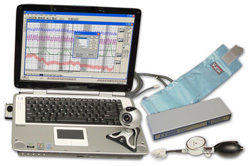Polygraph means “many writings.” Many also refer to it as a “lie detector or truth verifier.” The polygraph is an instrument that will record physiological changes occurring within the examinee’s body as the examiner asks a series of test questions. The polygraph instrument is basically a combination of medical devices that are used to monitor changes occurring within the examinee’s body. As an examinee is questioned about a certain event or incident, the examiner records and monitors the relative changes in a person’s blood pressure, heart rate, respiratory rate, and electro-dermal activities.
Today, many polygraph tests are administered using digital computerized equipment. Western Polygraph uses a Lafayette Computerized Polygraph Instrument.

Polygraph examinations are most often associated with law enforcement investigations, but there are also a number of other uses for the polygraph. Many government entities and law enforcement agencies require a pre-employment polygraph screening in conjunction with the background investigation prior to employment. Additionally, attorneys use polygraph to verify the truthfulness of their clients. Private citizens are using polygraph related to fidelity issues.
The polygraph components:
Respiratory: Two rubber expanding tubes filled with air, called pneumographs, are placed around an individual’s chest and abdomen. When the chest or abdominal muscles expand, the air inside the tubes is displaced. The computerized polygraph employs transducers to convert the energy of the displaced air into electronic signals.
Blood pressure/heart rate: A blood pressure cuff is placed around the person’s upper arm. Tubing runs from the cuff to the polygraph. Again, these signals are converted into electrical signals by transducers.
Galvanic skin resistance: This is also called electro-dermal activity and is basically a measure of sweat on your fingertips or palm of a hand. The fingertips are one of the most porous areas on the body and therefore are a good place to look for sweat. Fingerplates, called galvanometers, are attached to two of the examinee’s fingers. These plates measure the skin’s ability to conduct electricity. When the skin is hydrated (as with sweat), it conducts electricity much more easily that when it is dry.
